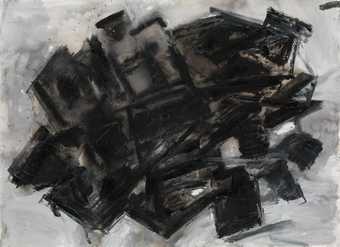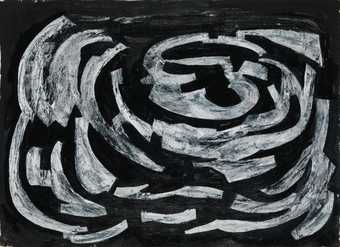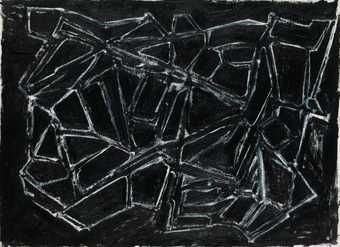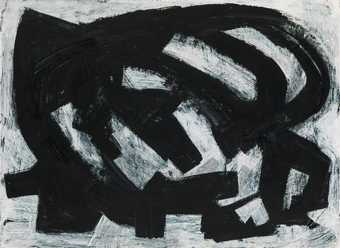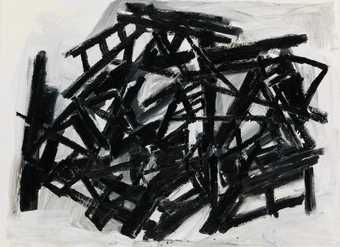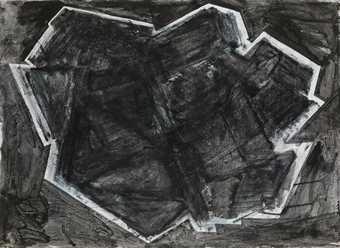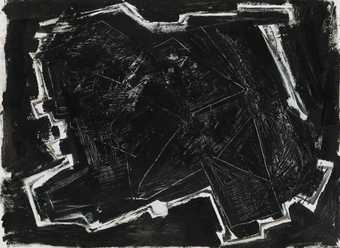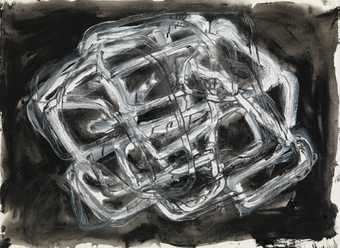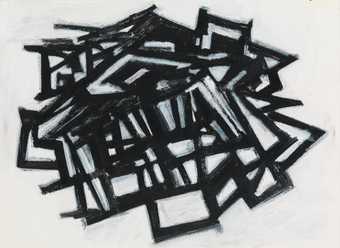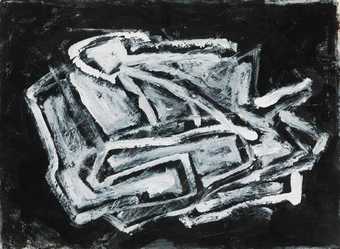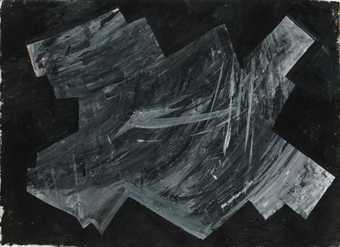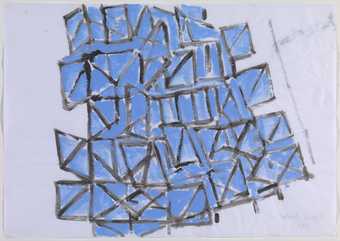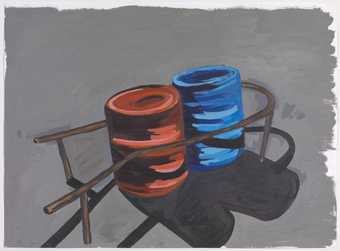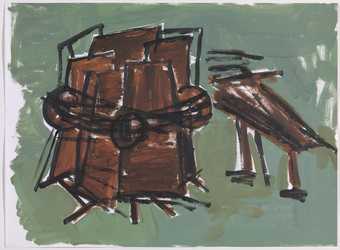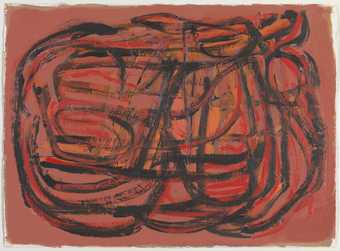
Not on display
- Artist
- Dame Phyllida Barlow DBE RA 1944 – 2023
- Medium
- Acrylic paint on paper
- Dimensions
- Object: 560 × 765 mm
frame: 650 × 840 × 39 mm - Collection
- ARTIST ROOMS Tate and National Galleries of Scotland
- Acquisition
- ARTIST ROOMS Tate and National Galleries of Scotland. Presented by the artist and acquired with assistance from the ARTIST ROOMS Fund, supported by the Henry Moore Foundation and Tate Members 2016
- Reference
- AR01243
Summary
This is one of a group of twelve drawings in acrylic paint on paper made over the years 2014 and 2015 (see Tate Artist Rooms AR01233–AR01244). Each drawing is titled in the same way with its number in the sequence. Painted in thick brushstrokes, the drawings retain great spontaneity of feeling, notable in the vitality of the swirling strokes, suggesting both solid and formless shapes which are built up by combining masses and thick lines of black and white paint. Most of the drawings follow a very similar compositional scheme, depicting a central motif outlined in either white or black against a background using the opposite colour. Numbers 1, 4, 5, 9 and 11 in the sequence depict a central motif with interlocking black planes or lines set against a muddy white background. In contrast, in numbers 2, 3, 6, 7, 8, 10 and 12 the shapes are outlined in white and are placed against a black background.
Drawing is central to Barlow’s practice and has become a daily activity for the artist. From quick sketches to finished works, her drawings are a relatively private part of her practice. In contrast to her sculptural works, which she makes surrounded by assistants, their production is a solitary pursuit, and they are primarily part of the artist’s thought process, in service of a larger project, without thinking of public display or of an audience. Barlow often draws before, during and after making sculpture. For her, drawing is a means to test out ideas for sculptures, to keep them alive as they are being executed and to evolve them into something unexpected that takes them away from their initial intent. Where her earlier drawings, such as Untitled 2004 (Tate T13841), for example, are more obviously related to her sculptural vocabulary, her later drawings such as these black drawings are often more abstract and independent in their form.
Barlow has described her drawing as ‘quick, intimate, open to change and spontaneous decision, and irrational changes of mind and direction’. While the process of sculpture can be a protracted one, drawing provides her with an intensely creative release of ideas as well as a tool for beginning to map out larger works. She has explained:
It has now become essential for me to get thoughts about possible works down as directly and as quickly as possible. It is a way of testing out a possible work’s potential for realisation: how it might or could be, as well as what, where, how big or small; as well as asking what kind of object is it, how much space it needs or owns. Then the proposed work begins to evolve on the paper with the pushing and spreading and liquidity of the paint and changes happen. The paper has become a space. The acrylic allows both edges and mass to argue with each other. Images can become blurred gestures, or can be more pronounced and as such be a guide for how to proceed with the physical and material making. (‘Phyllida Barlow in Conversation with Sophie Raikes’, in Henry Moore Institute 2012, pp.34–5.)
Further reading
Bad Copies: The Drawings of Phyllida Barlow, Essays on Sculpture, exhibition catalogue, Henry Moore Institute, Leeds 2012.
Carmen Juliá
April 2016
Does this text contain inaccurate information or language that you feel we should improve or change? We would like to hear from you.
Explore
- abstraction(8,615)
-
- non-representational(6,161)
-
- geometric(3,072)
- monochromatic(722)
- formal qualities(12,454)
-
- spontaneity(112)
You might like
-
Dame Phyllida Barlow DBE RA untitled: black 1, 2014
2014 -
Dame Phyllida Barlow DBE RA untitled: black 2, 2014/2015
2014–5 -
Dame Phyllida Barlow DBE RA untitled: black 3, 2014
2014 -
Dame Phyllida Barlow DBE RA untitled: black 4, 2014
2014 -
Dame Phyllida Barlow DBE RA untitled: black 5, 2015
2015 -
Dame Phyllida Barlow DBE RA untitled: black 6, 2015
2015 -
Dame Phyllida Barlow DBE RA untitled: black 7, 2015
2015 -
Dame Phyllida Barlow DBE RA untitled: black 8, 2015
2015 -
Dame Phyllida Barlow DBE RA untitled: black 9, 2015
2015 -
Dame Phyllida Barlow DBE RA untitled: black 10, 2015
2015 -
Dame Phyllida Barlow DBE RA untitled: black 12, 2015
2015 -
Dame Phyllida Barlow DBE RA Untitled
1997 -
Dame Phyllida Barlow DBE RA Untitled
2003 -
Dame Phyllida Barlow DBE RA Untitled
2003 -
Dame Phyllida Barlow DBE RA Untitled
2006

